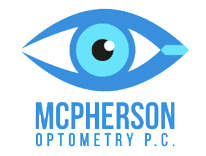Could Your Child Have Lazy Eye or Cross Eyes?
Lazy eye in North Syracuse NY, formally known as Amblyopia, causes children to have poor vision in one eye only. Unfortunately, the condition can become permanent when not treated early. The brain learns to favor the stronger eye and ignores the weaker one.
Recognizing the Symptoms of Amblyopia
The symptoms of lazy eye are not always obvious since having weaker vision in one eye does not necessarily indicate lazy eye. Typically, children do not receive a diagnosis of amblyopia until after an eye exam at McPherson Optometry. We urge you to schedule an exam for your child right away if you notice any of the symptoms listed below.
- Bumping into objects, especially if it seems to happen more often on one side of the body
- Crossed eyes
- Closes one eye and/or squints frequently
- Droopy eyelid
- Favoring one side of the body
- Frequently tilts their head to one side
Structural abnormalities in the eyes, which may be present from birth, are the most common reason that children develop lazy eye. The biggest risk factors associated with amblyopia include being born before week 37 of pregnancy, low birth weight, and developmental delays, whether diagnosed yet or not.
What All Parents Should Know About Strabismus
Strabismus, more commonly known as cross eyes in North Syracuse NY or eye misalignment, causes one eye to turn at an awkward angle while the other eye remains in a normal position. Each eye contains six muscles that typically work together to control eye movements. At least some of these muscles are defective in children who have cross eyes.
Although the condition can also occur in adults, it is typically due to stroke or another neurological condition. Below are the three primary types of strabismus.
- Esotropia, which causes the eye to turn inward
- Exotropia, in which the eye points outward
- Hypertropia, which causes an upward appearance of the eye
The symptoms of lazy eye and cross eyes greatly overlap with one another, with the latter also causing headaches, eye strain, and reading difficulties. Fortunately, we can treat both conditions with patching, a new eyeglasses prescription, or another standard remedy. Please schedule an appointment for your child today if you have any concerns.




Leave a Reply
Want to join the discussion?Feel free to contribute!